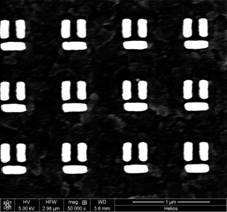Time:2013-08-04ClickTimes:
All-optical tunable plasmon-induced transparency (PIT) finds great
applications in the fields of ultrahigh-speed quantum information processing
and integrated photonic circuits. Owing to the small third-order optical
nonlinearity of conventional materials, the achieved operating pump
intensity was as high as GW/cm2 order. Moreover, it is very difficult to
obtain a material with a large nonlinearity and ultrafast response
simultaneously at the optical communication range. This has seriously
restricted the practical applications of PIT.
Gong’s group proposed a new strategy to achieve an ultrafast and large
third-order optical nonlinearity at optical communication range. They
fabricated a novel polycrystalline ITO/gold metamaterial. A large
third-order nonlinear susceptibility was achieved by using quantum
confinement provided by nanoscale crystal grains of polycrystalline ITO, the
hot-electron injection from gold nanostructure to polycrystalline ITO, and
the field reinforcement provided by plasmonic resonances. The threshold pump
power was reduced by four orders of magnitude. The threshold pump intensity
was reduced to 0.1 MW/cm2 order. An ultrafast response time of picoseconds
order was maintained by using the fast recombination process of carriers in
ITO crystal grains.
This work was published in Scientific Reports (Yu Zhu, Xiaoyong Hu, Yulan
Fu, Hong Yang, and Qihuang Gong, “Ultralow-power and ultrafast all-optical
tunable plasmon-induced transparency in metamaterials at optical
communication range”, Scientific Reports 3, 2338 (2013)). This work was
highly appraised by the reviewers “The authors succeeded to get a huge
third-order nonlinear susceptibility and tune the resonant wavelength of PIT
using low pump intensities between 0.1 and 1.0 MW/cm2. For conventional
semiconductor materials, such studies are quite difficult.” “This work is of
great fundamental interest in the field of plasmonics and metamaterial, and
also has important potential for ultrafast integrated photonic devices”
The work was supported by the Creative Research Group Project of the
National Natural Science Foundation of China, and the National Basic
Research Program of China.

| 
|
Figures:SEM image of the metamaterial sample (Left)
and ultrafast all-optical tenability of plasmon-induced transparency
(Right)
|
